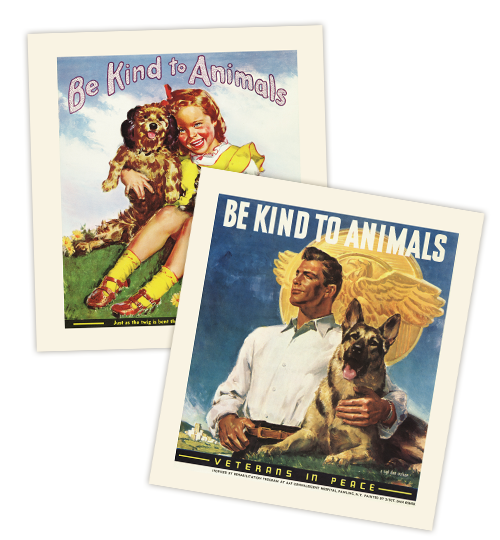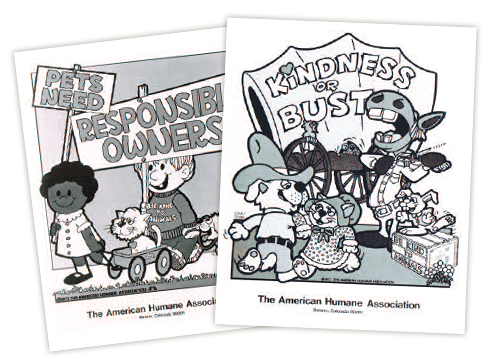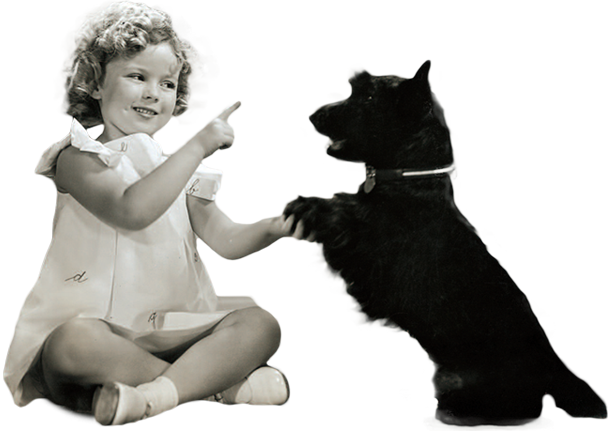Origins
On October 5-8 of that year American Humane held its 38th annual meeting in Atlantic City, New Jersey. Its leaders recognized that then, more than ever, they needed to step up and champion the issue of humane education and animal welfare.
During those four days in Atlantic City, American Humane leaders adopted a resolution that local humane societies and individuals across the country would observe a “Humane Sunday which shall be devoted to the consideration of humanity to all living creatures” and “that this Sunday be followed by a week to be devoted to a special plan for kindness to animals, and to be known as ‘Be Kind to Animals’ week.”
Several churches across the country had held annual “Mercy Sunday” events, where members of the clergy delivered sermons on the importance of the humane treatment of animals. Mercy Sunday was the forerunner to “Be Kind to Animals Week,” but the idea did not yet have the backing of a national leader in the humane movement.
Clergy of all denominations were provided sample sermons to use for Humane Sunday, teaching their parishioners the importance of being humane to all creatures great and small. Local humane groups and schools were likewise given toolkits to help them celebrate “Be Kind to Animals Week” in their own communities. This tradition of providing toolkits and campaign materials has continued to this day.
In the century since, associating the first full week of May starting on a Sunday (or occasionally late April or mid- May in the earlier years) with kindness and compassion for animals has been an indelible rite of passage for nearly every child in America. An annual poster contest has allowed children to imagine creative ways in which we all can be kind to our furry, feathered, and finned friends.

1915
The inaugural “Humane Sunday” and “Be Kind to Animals Week” are observed by humane groups across America from May 16-22. Though the sinking of the RMS Lusitania just several days before was fresh on everyone’s mind, the celebration went ahead as scheduled. American Humane president Dr. William O. Stillman reported that “the humane movement never received as much general publicity in the same length of time as during the few weeks before and including ‘Be Kind to Animals Week’ and ‘Humane Sunday.’”
1916
Humane Association to send a team to Europe to care for the sick and wounded animals used in battle, just as the Red Cross had been asked to do for humans. American Humane’s Red Star® Rescue team thus began its first assignment, rescuing and helping 68,000 wounded horses each month. Since the end of World War I Red Star has continued to care for animals in need caught in the path of both natural and manmade disasters.
1922
U.S. President Warren G. Harding issues an official proclamation on “Be Kind to Animals Week.” One of the major themes this year is the commemoration of the centennial for the passage of the “Martin Bill,” England’s first national animal protection act.
1927
Popular poet Edgar Guest pens a poem entitled "On Kindness to Animals,” which contains the verse:
They cannot ask for kindness
Nor for our mercy plead,
Yet cruel is our blindness
Which does not see their need.

1931
American Humane reports that 52,000 “Be Kind to Animals Week” posters were ordered for that year’s festivities, double the number over the year before and by far the most to date. Word of the new campaign continues to spread across the country.
1932
Morgan Dennis, the artist most famously tied to “Be Kind to Animals Week,” unveils the first of many posters for the week. Each year, his poster is a powerful visual representation of a person – usually a child – displaying an act of kindness toward an animal in need. His periodspecific details – from the fashions worn to even the model years of the cars – create a timeless snapshot of each particular year.
1936
to avoid animals crossing the roadway. Temple appears twice on the cover of National Humane Review, American Humane’s monthly publication, in June 1935 and January 1936, and her participation prompts national coverage.
1943
World War II, she writes: “Though it may seem to a good many people that a time when the world is hardly a kind world is not a time to emphasize kindness to animals, and that we should think primarily of our attitude toward human beings, I believe there is great value in continuing to train children in the proper attitude toward their pets.” She would cite the importance of this special week in her column virtually every year during this tumultuous decade.

1949
“Be Kind to Animals Week” is prominently featured on the cover and throughout an issue of the “Casper the Friendly Ghost” comic book. Tom, the mouse nemesis to cat Jerry of the “Tom and Jerry” cartoon shorts, resolves for once to be kind to his feline counterpart during a special “Be Kind to Animals Week” edition of their show.
1950
Porky Pig learns an important lesson of compassion on a special “Be Kind to Animals Week”-themed “Looney Tunes” short entitled “Dog Collared,” where he eventually befriends and adopts a dog who follows him everywhere.
1952
Noted author Fannie Hurst promotes “Be Kind to Animals Week” activities on a nationwide broadcast on CBS Radio heard by millions of Americans.
1959
On Sunday May 3, the nationally syndicated comic strip "Dennis the Menace"features a “Be Kind to Animals Week” theme, reaching out to children and adults alike with the importance of treating all animals with compassion."


1960
Following the lead of his comic strip character, child actor Jay North, the star of the sitcom “Dennis the Menace,” serves as spokesperson for the year’s celebration; he is joined by fellow CBS child star Jerry Mathers, better known as Beaver Cleaver on “Leave it to Beaver.”
1962
American Humane distributes more than 70,000 pieces of literature related to that year’s celebration. An editorial in the National Humane Review explains that “the idea really caught on. Across the country, humane societies and interested individuals campaigned for kindness.”
1966
“Bonanza” star Lorne Greene joins the cause, urging Americans to keep a watchful eye on their animals as dognapping and cattle rustling are still seen as widespread issues of the day.
1969
For the Golden Anniversary of “Be Kind to Animals Week,” Jon Provost, known by all the world as little “Timmy” from the hit television series, “Lassie,” is chairman; he is joined by a host of other honorary chairs from major TV shows, including Patty Duke.


1971
Betty White is appointed “National Kindness Chairman,” beginning her decades-long legacy of working with American Humane, which endures to this day.
1972
Comedy legend Carol Burnett is named “National Kindness Chairman” and helps to spread important tips for first-time pet adopters and for children on how to care for their new furry friends.
1973
Iconic movie cowboy John Wayne lends his voice as chair of the year’s celebration. Popular television show “Romper Room” promotes “Be Kind to Animals Week” to its millions of tiny viewers.
1975
Doris Day, the year’s “National Kindness Chairman,” says that the most important criterion for owning a pet is “to be a responsible pet owner.” Some 1,200 humane organizations across the country celebrate “Be Kind to Animals Week.” American Humane begins a campaign to have “Be Kind to Animals Week” officially recognized by the United States Congress, which would take more than a decade to happen.

1977
fit in perfectly with the year’s theme of “Americana.” American Humane writes in its annual campaign toolkit that “country-western entertainment is a totally American phenomenon developed at a grassroots level in the 19th century and subsequently spread to become an international rage, just as how much of American Humane’s work through the early years was also launched at limited local levels, eventually catching the public’s imagination.”
1982
who has worked with many animals on set throughout his career, is eager to lend his name because of his support of American Humane Association’s “No Animals Were Harmed®” program, which has protected animal actors on set since 1940. “I won’t allow a scene where animals are mistreated. I won’t tolerate it and never have. There’s no movie that’s worth it. I’ve loved animals all my life, and I’ve brought up my kids the same way, to respect every kind of living creature,” he says.

1985
Bruce Boxleitner, star of television’s “Scarecrow and Mrs. King” and the movie Tron, is named the chairperson that year. Boxleitner grew up on an Illinois dairy farm and at the time lived on a ranch north of Hollywood with his horses. “Living a rancher’s life teaches [my son] Sa m responsibility towards all living creatures,” he says. Nearly 30 years later he would again support American Humane Association by presenting an award at the 2014 American Humane Hero Dog Awards™.
1990
Just in time for its 75th anniversary, the 101st Congress passes a resolution officially recognizing the first full week of May every year as “Be Kind to Animals Week.” The bill, introduced by Senator Pete Wilson of California, states that “The people of the United States are indebted to animal protection organizations, state humane organizations, and local animal care and control agencies for promoting respect for animals and pets, educating children about humane attitudes, and caring for lost, unwanted, abused, and abandoned animals.”


1993
Newly inaugurated President Bill Clinton issues a proclamation on the occasion of the year’s “Be Kind to Animals Week,” stating “We celebrate this week in order to remember the many ways that animals help us. By serving as guides, animals aid the blind. As lookouts and detectives, animals assist in our military, customs, and law enforcement efforts. As friends and companions, pets befriend our children, ease the loneliness of the elderly and the ill, and entertain our families in our daily lives. We also salute the veterinary professionals and animal protection organizations that help us provide food, shelter, and medical care for animals and pets.”
1995
American Humane holds a national press conference commemorating the 80th year of “Be Kind to Animals Week,” and urges Congress to pass legislation allowing for residents in all federally subsidized housing to be able to have pets.
2000
Allie Pearlman, a 12-year old from Old Bethpage, New York, is named the year’s “BKA Kid Contest” winner and receives a $10,000 scholarship from American Humane Association. The fifth grader was a compassionate crusader for ending the process of live frog dissection at her school. As a result of her efforts, her school district purchases a computer program to simulate frog dissection instead of using live animals.


2005
Ninety years after the very first “Be Kind to Animals Week,” American Humane announces two co-winners of its annual “Kindness Kid” contest: Bagley Knox, who spent many hours volunteering at her local animal shelter, encouraged her Girl Scout troop to donate a portion of cookie sale proceeds to the shelter, and even gave up birthday gifts so her friends would donate supplies and food to the shelter that year; and Michael Valdez, who raised more than $70,000 to outfit as many police dogs as possible in his home state of Arizona with special stab- and bulletproof vests. Each winner received a $5,000 college scholarship.






